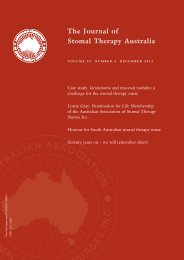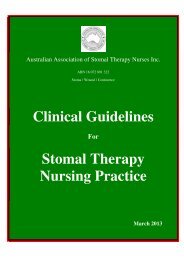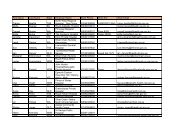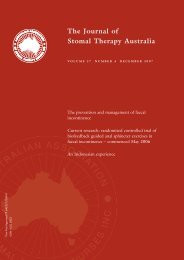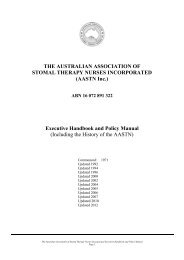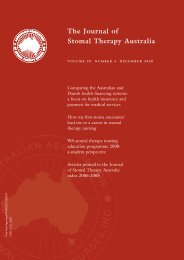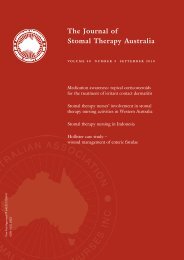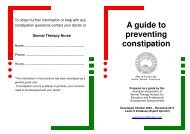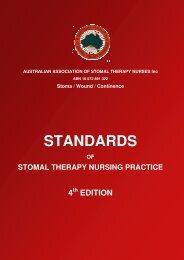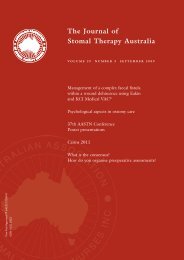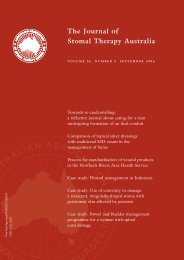The Journal of Stomal Therapy Australia - Australian Association of ...
The Journal of Stomal Therapy Australia - Australian Association of ...
The Journal of Stomal Therapy Australia - Australian Association of ...
You also want an ePaper? Increase the reach of your titles
YUMPU automatically turns print PDFs into web optimized ePapers that Google loves.
Beneath the waves<br />
Grant McLaren • Ileostomate since 24 December 2001<br />
After six weeks I was back to work (in Chile at 3,200 m above<br />
sea level) and after nine months I was re-acquainting myself<br />
with running, climbing in the Andes and riding my Harley<br />
around quaint little South American villages and pueblos. I<br />
was extremely fortunate to be strongly on the mend, but one<br />
favourite pastime was still to be conquered – scuba diving!<br />
Prior to the operation, I had been just short <strong>of</strong> titled ‘fanatical’<br />
as I would dive every weekend in the icy cold depths <strong>of</strong> the<br />
Humboldt Current that sweeps up the west coast <strong>of</strong> Chile. I<br />
missed it and longed for the camaraderie <strong>of</strong> my dive buddies.<br />
<strong>The</strong> question was out there – when?<br />
Probably like most ostomates, I thought that the world as I knew<br />
it was coming to an end when I had ‘X’ marked on my lower<br />
abdomen and was dutifully told that at that site I was going<br />
to have my small intestine pulled through a perforation in my<br />
body.<br />
It was my first sensation <strong>of</strong> surreality. At this shattering meeting<br />
with my specialist I was a distant observer trying to fathom<br />
the whole scenario, whilst also physically present. <strong>The</strong> ‘real’<br />
me was grappling with questions around recovery time, family<br />
and work. <strong>The</strong> ‘observing’ me was more pragmatic, thinking <strong>of</strong><br />
other alternatives, second opinions or even ‘putting it <strong>of</strong>f for a<br />
while’. But the two <strong>of</strong> me came crashing back together when I<br />
woke after the operation to find the most ugly thing on the face<br />
<strong>of</strong> the earth hanging out <strong>of</strong> my lower abdomen – I went into<br />
panic mode.<br />
What about intimacy, longevity, doing all the zany things <strong>of</strong><br />
my past – losing friends? <strong>The</strong> questions repeatedly hammered<br />
through my mind until out <strong>of</strong> the gloom appeared my STN – a<br />
ray <strong>of</strong> optimism, care and pr<strong>of</strong>essionalism. With smiling aplomb,<br />
she managed to dispel all <strong>of</strong> my immediate fears. We tackled and<br />
nailed all the points <strong>of</strong> domestic trepidation in quick time and I<br />
was quickly into ‘suck it up and get on with it’ mode – not least<br />
thanks to her motivation and the unwavering support <strong>of</strong> my<br />
family. <strong>The</strong>n I was onto solving the puzzle <strong>of</strong> which parts <strong>of</strong> my<br />
former life I could return to.<br />
On my twelve-month visit to the specialist I broached the<br />
subject and was given a cautious ‘thumbs up’ to give it a try at<br />
increments <strong>of</strong> 5 m depth at a time. So, with my long-term dive<br />
buddy we worked out a plan and I instructed him, “...if I bob<br />
up to the surface and my ileostomy bag has blown up and we<br />
are surrounded by flotsam and jetsam then you should swim<br />
for your life!”. Down we went, metre by metre until I was at a<br />
depth <strong>of</strong> 32 m. All went well and the return to the surface was<br />
uneventful – I was back in the briny depths and loving it!<br />
To date, I have amassed a total <strong>of</strong> 400+ dives – 50 <strong>of</strong> those since<br />
my operation; I have since been to the Red Sea, the Galapagos<br />
and Yucatan Peninsula, diving long/short, deep/shallow,<br />
tepid/icy, thick wet suit/Lycra body suit, salt/fresh water, <strong>of</strong>f<br />
rubber duckies/the back <strong>of</strong> cruise charters/the shore. In every<br />
combination I have had no problems.<br />
I continue to use a standard lead weight, belt. This can be<br />
somewhat uncomfortable, especially when wearing a thin<br />
dive suit and after successive dives – I have decided that<br />
my next buoyancy compensation device (BCD) will have an<br />
integrated weight system.This will also minimise the weight<br />
being manually handled before and after the dive. Care not to<br />
over-exert around the stoma area is required when trying to lift,<br />
say, a 10 kg weight belt from the water into a dinghy, especially<br />
if there is no help in the dinghy. I leave cords tied around a<br />
dinghy/duckie, so that I can tether the belt, BCD and tank, then<br />
retrieve them once in the boat.<br />
<strong>The</strong> art <strong>of</strong> climbing back into a dinghy/duckie has to be<br />
somewhat modified so that the stoma is neither dragged across<br />
the gunwale, nor over-exertion transferred to the stoma area.<br />
This can be overcome with a deft twist and roll motion, all <strong>of</strong><br />
which makes one look like a harpooned seal floundering on<br />
26 JOURNAL OF STOMAL THERAPY AUSTRALIA 2007 27(3)



